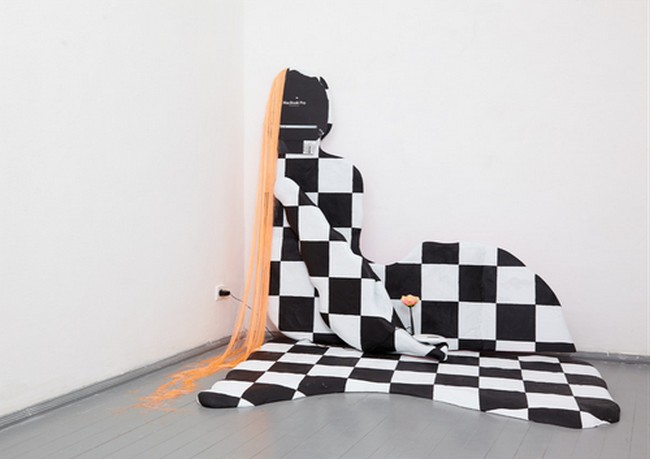Abstract Hungary
24 Jun - 07 Sep 2017

Zsófia Keresztes, It Wasn't Us Who Told Lizi to Lie down on the Cold Kitchen Floor, 2016. Photo: Krisztián Zana
ABSTRACT HUNGARY
24 June - 7 September 2017
Curators: Sandro Droschl, Áron Fenyvesi
Group exhibition :
Bak Imre, Ember Sári, Fajó János, Fogarasi Andreas, Halász Péter Tamás, Jovánovics György, Kaszás Tamás, Keresztes Zsófia, Ilona Keserü Ilona, Kiss Adrian, Kokesch Ádám, Komórczky Tamás, Lakner László, Little Warsaw, Makai Mira Dalma, Maurer Dóra, Nádler István, Nemes Márton, Puklus Peter, Rudas Klára, Szinyova Gergö, Tibor Zsolt, Ulbert Ádám, Vécsei Júlia
The issue of abstract art, which is always being updated, is being brought up again as part of an extensive exhibition of current Hungarian art, in order to take a closer look at more recent art and its effects in the face of heightened challenges. Abstract art in Hungary has a significant place in art history. It’s linked to artists such as Lajos Kassák and Victor Vasarely, as well as to artists who are active today, such as Imre Bak, Dóra Maurer, and István Nádler. In turn, these well-known artists are followed by outstanding middle and younger generations; their works are more strongly divergent in terms of content and form, and are still comparatively unknown.
Representing a broader narrative blueprint, "Abstract Hungary" features around twenty artists and their works, the majority of which are being shown for the first time in Austria. They’ll be interpreted by looking critically at the way the artists deal with their own approaches, as well as through current and past events in (art) history. Here, “abstraction” also plays an overriding role, in the sense of being an open-minded, productive attitude that goes beyond practiced formalisms; it can be understood as an art historical, discursive factor that is critical of time, as well as an element that links the participating artists. In an era with a complicated political, social, and economic environment, abstraction per se points beyond the local, seeking a distinct international language so that beyond all linguistic divides its connecting strengths in specific can be discussed.
The comprehensive exhibition will be accompanied with a catalogue and a side program.
24 June - 7 September 2017
Curators: Sandro Droschl, Áron Fenyvesi
Group exhibition :
Bak Imre, Ember Sári, Fajó János, Fogarasi Andreas, Halász Péter Tamás, Jovánovics György, Kaszás Tamás, Keresztes Zsófia, Ilona Keserü Ilona, Kiss Adrian, Kokesch Ádám, Komórczky Tamás, Lakner László, Little Warsaw, Makai Mira Dalma, Maurer Dóra, Nádler István, Nemes Márton, Puklus Peter, Rudas Klára, Szinyova Gergö, Tibor Zsolt, Ulbert Ádám, Vécsei Júlia
The issue of abstract art, which is always being updated, is being brought up again as part of an extensive exhibition of current Hungarian art, in order to take a closer look at more recent art and its effects in the face of heightened challenges. Abstract art in Hungary has a significant place in art history. It’s linked to artists such as Lajos Kassák and Victor Vasarely, as well as to artists who are active today, such as Imre Bak, Dóra Maurer, and István Nádler. In turn, these well-known artists are followed by outstanding middle and younger generations; their works are more strongly divergent in terms of content and form, and are still comparatively unknown.
Representing a broader narrative blueprint, "Abstract Hungary" features around twenty artists and their works, the majority of which are being shown for the first time in Austria. They’ll be interpreted by looking critically at the way the artists deal with their own approaches, as well as through current and past events in (art) history. Here, “abstraction” also plays an overriding role, in the sense of being an open-minded, productive attitude that goes beyond practiced formalisms; it can be understood as an art historical, discursive factor that is critical of time, as well as an element that links the participating artists. In an era with a complicated political, social, and economic environment, abstraction per se points beyond the local, seeking a distinct international language so that beyond all linguistic divides its connecting strengths in specific can be discussed.
The comprehensive exhibition will be accompanied with a catalogue and a side program.
